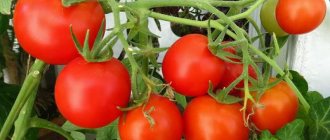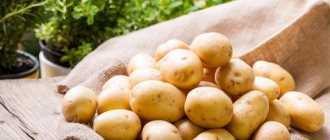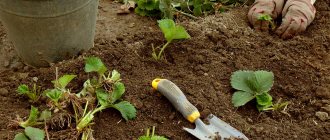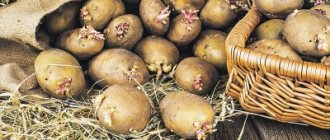Potato needs
During the growth period, tubers need nitrogen and phosphorus more than any other elements. Because the potato fruit is underground and located on the roots, this means that the root system must receive a lot of nutrients during the period of filling the tubers. Roots need phosphorus.
But this nutrient cannot be fully absorbed without the growth of green mass. Therefore, nitrogen is needed. Green manure for potatoes should contain large quantities of nitrogen and phosphorus. All that remains is to find out which plants contain these nutrients, buy seeds and sow the field.
There are several methods for using green manure for potatoes:
- the opposite, when the source of plant nutrition is the roots of companion crops;
- complete if above-ground and underground parts are used simultaneously;
- mowing, when only the mowed above-ground part is dug up, and the root system is left in the same place.
Depending on what nutrients were added to the potato field, one of the methods can be used.
Green manure for cabbage. Green manure for specific plants
Each plant is best suited to a specific list of green manure plantings. This does not mean that others are absolutely contraindicated. However, not all green fertilizers are capable of providing a specific crop with vitamins, macro- and microelements that are essential for it.
When choosing green manure for crops, it is important to remember that plants of the same family can infect each other with diseases.
Planting of greenery for specific plants is carried out at different times. For early-ripening tomatoes, it is better to sow it in the spring, and for late pumpkins and zucchini, sowing is carried out in the fall. It is necessary to proceed from the purpose of planting and the requirements of the individual crops to which green manure will be applied.
cucumbers
To choose the best green manure for cucumbers, you must first take into account the fact that the rhizome of the shrub develops close to the surface of the soil and does not go deep. It is necessary to achieve adequate nutrition of the plant with magnesium, nitrogen, phosphorus and calcium.
Suitable for these purposes:
- legumes: alfalfa, chickpeas, peas, clover;
- Cruciferous vegetables: mustard, rapeseed, rapeseed;
- cereals: oats, barley, wheat.
They will clear the soil of microorganisms, slow down the growth of weeds, protect the soil from weathering and attract beneficial insects, which, in turn, will pollinate the flowers. Any green fertilizer is suitable for cucumbers; there are no contraindications. But it is not advisable to sow pumpkin families after carrots and cabbage.
Previously, many gardeners believed that it was possible to plant cucumbers in the same place only once every four years, since they released harmful toxins into the soil. However, now that green manure has appeared, there is no need to wait such a long time.
Tomatoes
Tomatoes love loose soil rich in nitrogen and minerals, where weeds do not grow. An ideal option for nightshades would be phacelia, because it decomposes quickly and perfectly slows down the growth of grass. You can choose any legumes and cruciferous vegetables, as well as grains. They will also make excellent green manure for tomatoes.
You can sow either between rows or in bulk. Bright marigolds will look beautiful in tomatoes. Fertilizers will have to be alternated annually so as not to cause addiction in plants and soil.
You can sow green manure not only in spring, but also in autumn. They will overwinter well under the snow, and with the onset of warm days they will instantly grow lush foliage.
You should not plant dope and nightshade next to tomatoes, as they contain toxins.
Cabbage
Cabbage is in dire need of good nutrition, so nitrogen “suppliers” should be selected that will saturate the soil with humus, organic matter and minerals. This could be, for example, clover, sweet clover or alfalfa. Lupine perfectly fights wireworms, which cabbage is susceptible to, and copes well with bacteria. Any legumes are ideal, but cruciferous crops such as mustard, rapeseed, and radish cannot be planted.
Fertilizers are applied first in the spring, during planting, and then throughout the season for feeding.
Potato
Potatoes are especially susceptible to diseases and harmful beetles. By planting legumes next to the beds, you can best saturate the soil with nitrogen and potassium. Cereals will help improve the soil structure, and cruciferous vegetables will cope well with pests.
The best neighbors for potato tubers will be clover, mustard, flax, radish, and phacelia.
Green manure is applied to potatoes during planting or after harvesting to prepare the soil for the next season. The greens are plowed between the rows, but you can add them directly to the holes.
Green manure for potatoes is most often applied in the fall, 1.5 months before frost. Therefore, they choose cold-resistant ones so that they stand until the tubers are harvested.
The best green manure for potatoes
According to reviews from gardeners who have tried many plants that enrich the soil, the best green manure for potatoes are legumes:
- peas - can be sown simultaneously with tubers, because they sprout earlier and attract nutrients with their roots, namely nitrogen;
- alfalfa is a useful plant not only as green manure after potatoes in August, but is also used as animal feed, rich in nutrients beneficial to humans - fresh herbs can be used in cooking;
- lupine, whose beans replace soybeans, greens are used in the nutrition of animals and people, contain 50% protein, 20% oil, similar in quality to olive oil;
- sweet clover is a medicinal plant, a honey plant, contains a lot of useful nutrients for domestic animals, grows large - up to 2 m in height;
- vetch is one of the fastest ripening plant species, undemanding to air temperatures, suitable for feeding animals in its green form and beans, and used as green manure for potatoes before winter.
The effect of these plants on the soil is similar to manure, but it takes longer to decompose manure, it costs more than seeds, and it requires more labor - prepare compost or scatter it over the field and dig it up.
Green manure for potatoes is easier, cheaper and more versatile to use, since plants can be used in other areas - for treatment, animal nutrition. In a word, planting companion plants will not be superfluous, but will bring double benefits.
Benefits of green manure for potatoes:
- rotting plants activate the activity of soil bacteria, for which plant residues serve as food;
- maintain the level of humidity in the soil - it does not erode or be washed away by rain;
- weeds cannot compete with green manure because they have deep roots and grow quickly, taking nutrients from the weeds;
- contain phytoncides that garden pests do not like, there are fewer of them on plants and in the soil;
- enrich the soil with the main nutrients - nitrogen, potassium and phosphorus.
The last point is the most important, since with the help of green manure you can increase the yield without using mineral fertilizers.
Sowing time
The success of green manure lies not only in the right choice of crop. It is necessary to sow correctly at the optimal time. Green manure crops are sown in spring or autumn.
in autumn
In autumn, they are sown no later than 1.5 months in advance to establish stable cooling. During this time, they will sprout and grow to approximately 20 cm. Mow the plants before flowering begins. The greenery is not removed, but superficially embedded in the soil so that it has time to partially decompose before winter.
Sequence of actions for autumn greening:
- Remove potatoes and any remaining tops and grass.
- The area is being dug up.
- Phosphorus-potassium fertilizers and nitrophoska are applied to each square, 30-40 grams.
- The plot is densely sown with the selected crop.
There is a group of green manures that, after planting in the fall, do not need to be mowed for the winter, for example, rapeseed, rye, and vetch. Sow seeds scattered around the site or in the grooves between potato beds. Maintain a planting depth of 1.5-2 cm.
On a note!
For such purposes, crops with a short growing season are used. It is advisable to sow them after harvesting potatoes of early or mid-season varieties.
Sowing of green manure after potatoes is carried out approximately in mid-August. In the spring, the emerging seedlings are plowed into the soil before planting potatoes (approximately 10-15 days before).
in spring
They begin sowing green fertilizer for potatoes as soon as the snow melts. The earth should warm up to 10-12 degrees. The soil is pre-fertilized with mineral fertilizers. As the crop grows, they are processed and converted into an organic form convenient for potatoes.
Sowing potatoes is done in 2 ways:
- Make small grooves. Seeds are sown in them. Cover the crops with soil.
- On the ground surface. The seeds are carefully scattered around the area. They are covered with a thin layer of humus or peat on top.
Planted plants require abundant watering, as the soil dries out quickly. After the sprouts appear, watering is carried out several more times. It is not necessary to remove green manure before planting. Potatoes are planted in holes. And the greens are mowed and used as mulch. You can mow with a sickle, scythe or lawn mower.
Using green manure is an excellent way to fertilize the soil, which is not inferior to organic matter and mineral fertilizers. In addition, green manure helps fight pests and weeds on the site. To obtain the desired result, it is important to choose the right crop for planting and sowing time.
When to sow - autumn or spring
Features of the growth of legumes are increased germination and a rapid increase in green mass due to the accumulation of nitrogen in the tissues. Gardeners use this feature for their own purposes - to return plants back to the soil in order to enrich the soil and feed other crops.
Video: Green manure - potatoes on poor land
During the summer season, legumes can grow twice, so they should be used in spring and autumn. Rules for sowing green manure for potatoes:
- add seeds to the treated soil - for this you can apply mineral fertilizers, and the plants will convert them into safe organic matter;
- in the spring they are planted in late March early May, depending on the temperature, in the fall a month and a half before the cold snap, the seedlings should grow to 15 - 20 cm and have time to decompose in the ground - for this they need two weeks;
- You need to mow the plants before the seeds appear, so that they don’t fall back into the ground, as they will be difficult to remove later.
Green manure plants need watering so that they quickly process nutrients. The fact is that useful nutrients can be found deep in the soil, and they can only be removed from there with sufficient moisture. Therefore, in arid climates, it is recommended to regularly water green manure crops in front of potatoes in the spring until mowing.
You can mow the plants before planting them in the soil either manually or with a lawn walk-behind tractor.
Important! If the amount of greenery on the site exceeds all expectations, you do not need to add all of it to avoid souring of the plant residues. Part of the fertilizer is applied to other beds for other crops.
Growing rules
May be interesting Autumn feeding of bees - when, with what, how? How to properly germinate wheat for food? What are artificial plants and how can they be used
When choosing green manure crops, the type of soil is taken into account. Legumes are planted in swampy, clayey areas. Lupine will not grow in such soil. Sainfoin is sown on heavy rocky soils. Cereals are sown in poor soils.
An important rule to follow when choosing a plant is that you cannot plant green manure of the same family as the crop that will grow after it.
It is advisable to plant cereals after harvesting, as they attract wireworms.
Before planting, the soil is cultivated so that it is loose. You need to sow seed into the furrows and cover the top (you can use a rake). Watering is carried out carefully so that the seeds do not end up on the surface.
Consumption per hundred square meters is approximately 2 kg. When sowing, the planting density of each plant is taken into account. If the plantings are thickened, the plants will begin to rot. At the same time, rare crops will also not produce the desired result. Greens are cut before they begin to bloom.
Which green manures are not suitable for potatoes?
Cereals are also sown as predecessors - wheat, oats, rye, but they do not contain enough nitrogen and phosphorus, so they will not bring much benefit. The same goes for phacelia, white mustard, and rapeseed.
Their nutritional composition is suitable for other garden plants, so it is better to use them before tomatoes and cucumbers. You can apply more than the prescribed norm, but then the fertilizer will take longer to be processed in the soil, which is not good in the spring, since you may be late with planting potatoes.
It doesn’t matter what kind of green manure to plant after potatoes in the fall. It could be anyone. Mustard disinfects soil well, and in addition, it is resistant to cold.
Sedation of potatoes by the cruciferous family: representatives, their features and application
For the garden, the most common potato green manures are radish and mustard.
Oilseed radish, as a green manure fertilizer for potatoes, is grown on heavy clay soils. Massive roots are capable of loosening soil of any complexity, preventing erosion and drying out of the earthen surface. The time for sowing and cultivating the plant is April-October (before the 15th). Since radish is frost-resistant, it is planted as green manure immediately after harvesting.
The planting process can be done in two ways: by planting seeds to a depth of 3 centimeters or by scattering them throughout the garden. For 1 square meter you need 2-4 grams of seeds. If sowing is carried out between rows, then the distance from pea to pea should be 15 centimeters or more. After a month, you can cut off the tops and introduce them into the ground as green manure for potatoes.
1. Wheatgrass and other weeds do not grow next to oilseed radish. 2. The plant destroys rot and soil pests.
Mustard is not afraid of frost, so it is sown a couple of weeks before their onset. In addition, the plant is an excellent tool in the fight against pests such as slugs, wireworms, nematodes and pea moths, as it accumulates sulfur. Planting potatoes after this green manure gives a rich harvest. The roots attract worms, which promotes the formation of humus. Thanks to this green manure, root crops retain their beautiful appearance and do not rot.
To accelerate the decomposition of green mass, biostimulants are used. You can sow mustard together with vetch.
You can also get rid of the Colorado potato beetle and mole cricket with the help of mustard, planting it between the furrows when sowing potatoes. Plants are not cut until it is time to harvest.
Joint plantings
Joint planting of vegetable and green crops is very important when the area of land is limited. In addition, they help increase the overall yield of garden crops and protect them from damage by many pests and diseases.
- Beans grown between rows of potatoes make it possible to further enrich the soil with nitrogen, and potatoes protect legumes from bruchus.
- Marigolds, nasturtium and calendula prevent potatoes from being damaged by the potato nematode.
- White cabbage, corn, onions and garlic, eggplant and spinach, horseradish and mint are mutually beneficial neighbors for potatoes.
How to prepare the soil
Green manure, like any crop, requires preliminary soil preparation before planting. After harvesting, the ground is leveled using a rake or other tool, and nitroammophos (at the rate of 10 liters per hundred square meters).
If the acidity of the soil is high, then you can add a little lime . Very dry soil must be watered before planting green manure. For these purposes, it is better to use a shower head. Only after this can you proceed directly to sowing the seeds and planting them.
If there is high acidity, it is necessary to lime the soil before planting green manure.
The effect of using green manure
Green manure is an excellent means of increasing productivity because they: • enrich the soil with useful substances necessary for good potato growth; • can even completely replace manure; • improve the structure of the soil, making it looser and more moisture-absorbing; • reliably protect the earth from erosion, blowing, and overheating; • suppress the growth of weeds; • help reduce the number of pests.
Video: Green manure in the garden.
Natural farming Experienced summer residents understand that green manure is an excellent weapon in the fight for the harvest. Their skillful use helps the soil maintain fertility and nourish the vegetables that the summer resident grows on his plot. The earth always responds gratefully to such care for it and allows you to collect excellent harvests even on a small summer cottage.
What are green manures and why are they needed?
Green manure is a “green manure”, auxiliary plants that help enrich and loosen the soil, protect crops from diseases and pests.
In our gardens we grow a whole host of green manure plants:
- Cereals: grass of spring barley and oats, winter rye and wheat, sorghum and millet. Mixtures of timothy, ryegrass and fescue are also suitable.
- Legumes: forage field species of peas and beans, as well as soybean greens, alfalfa, clover, annual lupine, spring vetch, beans, chickpeas, seradella, lentils, sweet clover, sainfoin.
- Cruciferous: oilseed radish, mustard, rapeseed, rapeseed greens.
- Hydrophilic: phacelia.
- Amaranthaceae: amaranth itself, as well as amaranth.
- Buckwheat, represented by buckwheat.
- Asteraceae: The green part of marigolds and sunflowers.










